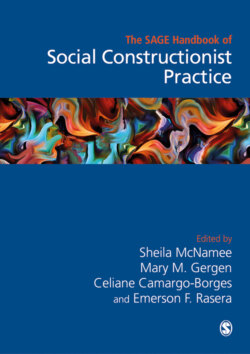Читать книгу The Sage Handbook of Social Constructionist Practice - Группа авторов - Страница 82
На сайте Литреса книга снята с продажи.
Textual Adventures
ОглавлениеBecause traditional scholarship takes the form of writing, the most attractive invitation into performative work has been furnished by literary traditions such as biography, fiction, and poetry. Constructionist ideas invite one to experiment with these traditional forms. In the case of biography, for example, in an exploration of her own eating disorder, Lisa Tillmann-Healy (1996) shows her hidden bulimia via short vignettes, from early childhood to her twenties. Karen Fox's (1996) juxtaposition of three voices was extracted from interviews to form a pseudo-conversation: the first voice was that of her client, who as a young girl, had been sexually abused by her grandfather; the second a man now in prison for sexually abusing his granddaughter; and the third, her own, commenting on her feelings. Kenneth and Mary Gergen (1994) composed a duography, that is, a double biography, which began with the voices of two independent individuals and gradually melded them together over the course of the text.
The logic inherent in this tradition also finds lively development in autoethnography (Bochner and Ellis, 2016; Sughrua, 2016), in which scholars use themselves as instruments for illuminating a particular socio-cultural condition. The shift from ethnography to autoethnography is an important one, as it replaces the authority of the outside observer with the voice of the person in-situ (Ellis, 2004). This work has frequently expanded to include novels and theatrical scripts (Ellis, 2004; Richardson, 1997; Richardson and St. Pierre, 2005). Excellent compendiums of this work are found in edited volumes by Ellis and Bochner, Composing ethnography (1996) and Bochner and Ellis, Ethnograpically speaking (2002).
More radical in its challenge to realist representation is the work of social scientists who have turned to fiction as a means of inquiry. The enormously expanded range of expression allowed by fictional traditions enable them to illuminate their subject matter in what are often seen as more effective and penetrating ways than traditional empirical study. Pfohl's (1992), Death at the Parasite Café was a courageous and innovative entry into the professional literature – at once serious and playful. Also adventuresome are dialogues between fictitious characters. For example, in Michael Mulkay's (1985) groundbreaking work, fictional characters, Marks and Spencer, along with inebriated participants at the Nobel ceremonies, dispute about chemistry, in a parody of issues in sociology. Exploration now abounds. For example, Diversi (1998) has used short stories to provide a glimpse of street life for homeless youth in Brazil, and Muñoz (2014) has employed fictional stories to explore dimensions of silence in interpersonal communication.
Poetry has long been viewed in the culture more generally as a way of communicating wisdom, insights, or passions in more powerful, economic, and more highly nuanced ways than prose. To explore these potentials in social science, for example, Mary Breheny (2012) has provided a poetic representation of aging; Anne Görlich (2016) has introduced us to the lives of adolescent dropouts, and Laurel Richardson has used experimental writing to illuminate her life in Fields of play (1997). As an alternative to authoring their own poems, other social scientists have drawn from the words of others – typically those to whom they wish to give voice – to form a poetic integration. For example, Steven Hartnett (2003) has provided insight into prison life through the poems of inmates. For more detailed accounts of the use of poetry in social research see Richardson and St. Pierre (2005), and Faulkner (2009). More on the performative use of text in general can be found in Pelias (2014), and Gergen and Gergen (2012).
